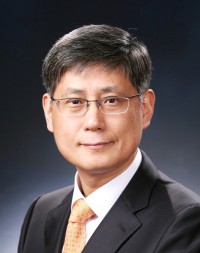
Sang-il Park, Park Systems boss.
By Matin Durrani
Day three for the Physics World editorial visit to South Korea saw news editor Michael Banks spend the day at the KSTAR fusion facility while I was at atomic-force microscope (AFM) manufacturer Park Systems in Suwon.
South Korea is, of course, a key player in fusion science, being a long-standing member of the ITER experiment being built in the south of France. But as Michael is now in the south of the country – in Pohang to be precise – I haven’t had full details of how his visit to KSTAR went. He did, however, e-mail me to say that he’d asked his contact at the lab whether they’d ever had any other visits from journalists. She said they hadn’t, but there was once this very famous scientist who had taken a tour of KSTAR – step forward none other than the physicist who’s on just about every UK TV science show at the moment: Brian Cox.
As for me, I had an interesting day at Park Systems, which was set up by the physicist Sang-il Park shortly after his PhD in California in the 1988 where he’d worked with the group at Stanford University where AFM was born. He initially ran the business out of the US for nine years, before returning to South Korea in 1997 and the company has since grown to become a world leader in AFM.
I spent an hour interviewing Park and will be writing up the conversation for the Physics World Special Report on physics in South Korea, due out in September. I don’t want therefore to reveal everything Park said but he did give me some fascinating insights into the general business environment in South Korea.
I hadn’t realized, for example, that most of the big names associated with the country, such as Samsung and LG, originally began as state-run businesses in all but name and nowadays, despite the existence of a market economy in the country, exert a huge – and some would say unfair – influence on all aspects of South Korean life. Their presence makes it hard, Park suggested, for smaller firms like his own to make it big. To back up the point, he showed me a pile of data that indicated that almost all of the biggest Korean firms are old-stagers founded well before 1970; in the US, in contrast, the top firms are largely dominated by newcomers.
But I wouldn’t want to suggest that Park is bitter; far from it, he insisted how fortunate his life has been to have developed a company and to have been in California at the right place, at the right time and with the right people just as AFM was being developed.
I’m now holed up on the 22nd floor of a hotel in the financial district of Seoul with a (cue travel-writing cliché) spectacular view of the twinkling lights of the city below. So far the visit has all gone to plan and I for one have found everyone really friendly.
One thing I hadn’t quite expected though was the sheer number of coffee shops. It looks like the Koreans have definitely developed a taste for coffee, especially the iced stuff. In fact, their love of coffee is one aspect of modern Korean life (especially in the Seoul district of Gangnam) that PSY mocks in his 2012 worldwide hit “Gangnam Style”, the lyrics to which (when translated) apparently refer to “a classy girl who knows how to enjoy the freedom of a cup of coffee” while he, PSY, is “a guy who one-shots his coffee down before it even cools down”.
So now you know.
in the case of South Korea, one has to understand as to how a resourcelesss and very poor country developped into a high tec land in about one and half generations.
The Korean government in years gone by piled funds into a handful of firms that have succeeded through the sheer level of backing. As I mentioned, while those big firms have done well, it’s as a consequence been harder for others to make their own mark. A strong central government that wielded much power was a key reason why Korea could transform itself so fast.
Over time, I have had multiple discussions with the persons who intiated this transformation. These persons sat down and set up a “vision” for their country and a strong and even dictatorial government backed this vision thoroughly over the years triggering the take-off and transforming the country in such a short time. The same is true for Singapur and Malaysia.
Trackback: Blog - physicsworld.com